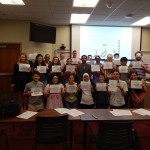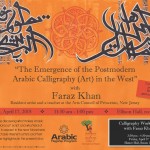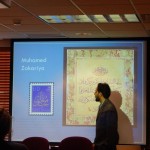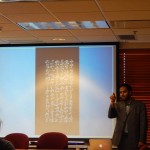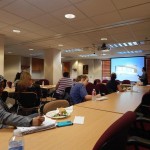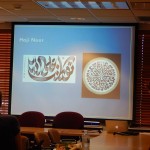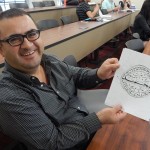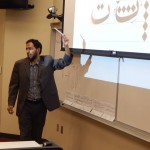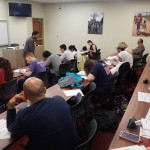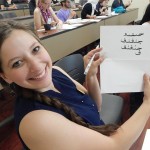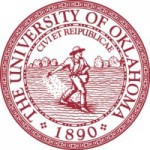WHYY Interview with American Islamic Artist Faraz Khan
The Beauty of Arabic Calligraphy Becomes Art
NEWSWORKS, WHYY
Local News for Philly Region
THE ARTFUL BLOGGER
By Ilene Dube
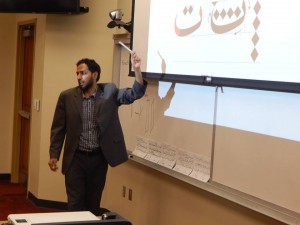 Faraz Khan is promoting his upcoming course at Rutgers University on Facebook. The ability to read and write Arabic is not a prerequisite for Introduction to the History and Practice of Arabic Calligraphy. “This course will take students on a historical journey through different time periods and lands where written Arabic flourished,” Khan says. “Students will be exposed to different forms of Arabic lettering to examine a majestic art form that flourished not only to beautify the Quran but elementary in architecture and home décor.”
Faraz Khan is promoting his upcoming course at Rutgers University on Facebook. The ability to read and write Arabic is not a prerequisite for Introduction to the History and Practice of Arabic Calligraphy. “This course will take students on a historical journey through different time periods and lands where written Arabic flourished,” Khan says. “Students will be exposed to different forms of Arabic lettering to examine a majestic art form that flourished not only to beautify the Quran but elementary in architecture and home décor.”
Khan has been named the 2015 Arts Council of Princeton Anne Reeves artist-in-residence, and will be leading seven events in Princeton that demonstrate his unique and contemporary approach to Arabic calligraphy, beginning at Communiversity, where Khan will show participants how to write their names in Arabic on pendants to be displayed in Palmer Square.
Among the other events will be a discussion of The Canticle of the Birds, an illustrated manuscript of a Sufi text – the original is in the Metropolitan Museum of Art – in which all the worlds’ birds have transcended from human souls.
On June 26, participants will be invited to the Princeton Public Library with old books that are no longer useful. Khan will paint Arabic calligraphy on them, words “pertaining to knowledge and wisdom,” he says. He will do this for eight hours as people observe.
In September, outside of Princeton University Art Museum, Khan will demonstrate Arabic calligraphy, words, stories and cartoons made with light. Using a slow shutter speed, Khan will project patterns of light on a screen. “The audience will see movement of light but the meaning will come true when it’s projected,” he says. “It will have a graffiti element, taking light and showcasing attention on surroundings, projecting an image based on cumulative random flashes of light that don’t have meaning to us until you sequence it together and it becomes a light story.”
In October, at the conclusion of his residency, Khan will have an exhibition at the Arts Council’s Paul Robeson Center for the Arts, The Making of a New Script. “I will be taking home décor items such as tables, chairs and curtains, adding a new style of calligraphy,” he says. “There will be a lot of painting, to give a new feel to generic items to give new meaning.” He wants to showcase the “uniqueness of the language and calligraphy style to beautify surroundings.”
Khan lived the first 14 years of his life in Pakistan, then moved with his family to New Jersey “to escape turmoil and instability. My parents came to seek a better education for their children,” he says.
He first learned Arabic calligraphy about five years ago – growing up in Pakistan, the language was Urdu, which uses Arabic letters. “But Arabic wasn’t my first language, I had to learn it. I studied styles of Arabic calligraphy, reading texts on architecture for my master’s degree. I wanted to understand what differentiates one style from another and wanted to help others see this.
“Once I jumped in I felt attached,” he continues. “So much can be done with script and artistic style. Traditionally, there were rules about ratios and proportions and the angle of pen.”
Kufic script, the oldest calligraphic form of the various Arabic scripts, is linear and bold. It developed at the end of the 7th century in Kufa, Iraq, and until about the 11th century it was the main script used to copy Qurans.
Naskh script is a basic script, the first that most learn to read and write. “It’s very simple and elegant but legible,” says Khan. “Most non Arabs read the Quran in Naskh. People like to read the Quran in Arabic so children are taught Naskh because it is simpler in style and readability.”
Khan uses a combination a combination of scripts. “It’s a more modern approach. Most people write according to a standard style but now people are creating their own unique way. It’s about creating art. In the Arab region calligraphy is an art, not a craft. Buildings and monuments are decorated with scripts to beautify the sculpture, whether inside or outside.”
The tools of his trade are paint, glitter and glue. “Traditional tools were bamboo sticks cut at certain angle and dipped into black india ink. The pen holds ink for only a few words until you have to dip again.” Khan’s artwork is bigger so he uses uses graffiti markers and brushes. For light writing, his light source is often a cell phone.
Khan likes using calligraphy to build a bigger picture. He recently made an outline of the Paul Robeson Center, the Arts Council building, and instead of painting with different colors, he wrote calligraphy in it. “It looks like painting but if you look closer you see calligraphy in colors,” he says.
“American Muslim education has focused on medical, legal and engineering, but art appreciation is often neglected, cutting off American Muslims from their heritage,” Khan continues. “They wouldn’t dare to touch a bamboo stick to make art — it hit me on a deeper level, our community wasn’t creating art, creating something beautiful and sharing with others. I felt it was a duty for me, to create and share art that is living, not just mimicking masters — many just copy standard styles — but I add to it.”
For his exhibition, Khan is creating a new script he calls Princetoni. “Different regions have their own scripts, and I’m continuing that legacy. It’s something to be proud of, shared, learned and admired.”
Faraz Khan, Arts Council of Princeton Anne Reeves Artist-in-Residence 2015 will begin his seven events with a community calligraphy-based art project for Communiversity, April 26, 1-6 p.m., Palmer Square Green.
Lecture: The Conference of the Birds or Islamic Art Lecture
May 21, 7 p.m.
Solley Theater, Paul Robeson Center for the Arts
Scheduled speaker: Princeton University Professor, Department of Near Eastern Studies, Michael Barry
A Bookcase of Art
June 26, 1-8 p.m.
Princeton Public Library
Arabic Calligraphy Workshops
July 11, 2015
Arts Council of Princeton
Calligraphy Workshop at Princeton Shopping Center
August 13, 2015
Princeton Shopping Center
5:30 p.m.
Light Art Calligraphy Performance
Sept. 10
Princeton University Art Museum Lawn
Making of an American Script
Faraz Khan, exhibition in Taplin Gallery
October 1-31
_____________________________________________________
The Artful Blogger is written by Ilene Dube and offers a look inside the art world of the greater Princeton area. Ilene Dube is an award-winning arts writer and editor, as well as an artist, curator and activist for the arts.


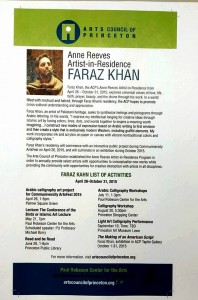
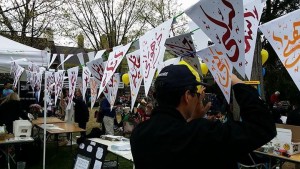
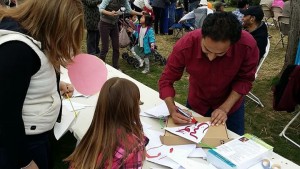
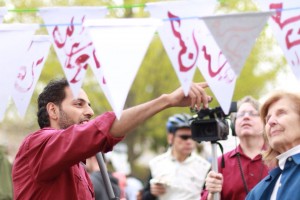
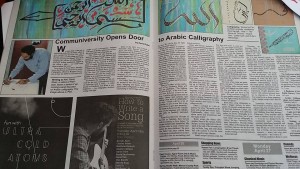












 But in reality it looked more like Mr Schwarzenegger’s infamous plead for the kids in the class to be silent.
But in reality it looked more like Mr Schwarzenegger’s infamous plead for the kids in the class to be silent. Okay, that’s not funny.
Okay, that’s not funny.